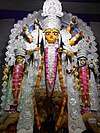Culture of West Bengal
The culture of West Bengal is an Indian Culture which has its roots in the Bengali literature, music, fine arts, drama and cinema. Different geographic regions of West Bengal have subtle as well as more pronounced variations between each other, with Darjeeling Himalayan hill region and Duars showing particularly different socio-cultural aspects.
| Part of a series on the |
| Culture of Bengal |
|---|
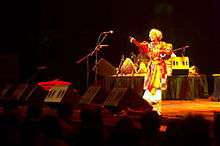 |
| History |
|
|
Mythology and folklore |
| Cuisine |
|
Festivals
|
|
Genres
Institutions
Awards
|
|
Music and performing arts Folk genres Devotional Classical genres
Modern genres
People Instruments Dance Theater
Organizations People |
|
Sport
|
|
|
| Part of a series on |
| Bengalis |
|---|
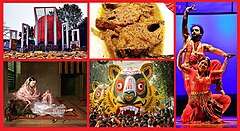 |
|
Bengali homeland |
|
Bengali culture
|
|
Bengali symbols |
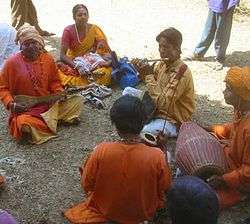
West Bengal's capital Kolkata—as the former capital of India—was the birthplace of modern Indian literary and artistic thought,[1] and is referred to as the "cultural [or literary] capital of India".[2][3] The presence of paras, which are cluster of neighbourhoods that possess a strong sense of community, is characteristic of West Bengal.[4] Typically, each para has its own community club and, on occasion, a playing field.[4] Residents engage in addas, or leisurely chats, that often take the form of freestyle intellectual conversation. However, with the growth of apartments, expansion of neighbourhoods and rapid urbanization, this culture is on decline. Adda is very common among elder residents.[5][6] West Bengal has a long tradition of popular literature, music and drama largely based on Bengali folklore and Hindu epics and Puranas.
Literature
The Bengali language boasts a rich literary heritage, shared with neighbouring Bangladesh. West Bengal has a long tradition in folk literature, evidenced by the Charyapada, Mangalkavya, Shreekrishna Kirtana, Thakurmar Jhuli, and stories related to Gopal Bhar. In the nineteenth and twentieth century, Bengali literature was modernized in the works of authors such as Bankim Chandra Chattopadhyay, Michael Madhusudan Dutt, Rabindranath Tagore, Kazi Nazrul Islam, and Sharat Chandra Chattopadhyay. Coupled with social reforms led by Ram Mohan Roy, Swami Vivekananda, and others, this constituted a major part of the Bengal Renaissance.[7] The middle and latter parts of the 20th century witnessed the arrival of post-modernism, as well as literary movements such as those espoused by the Kallol movement, hungryalists and the little magazines.[8]
Theater and films
Among other types of theater, West Bengal has a tradition of folk drama known as jatra.[9][10] Kolkata is the home of the Bengali cinema industry, dubbed "Tollywood" for Tollygunj, where most of the state's film studios are located.[11] Its long tradition of art films includes globally acclaimed film directors such as Academy Award-winning director Satyajit Ray, Ritwik Ghatak, Mrinal Sen, Tapan Sinha, and contemporary directors such as Aparna Sen, Buddhadeb Dasgupta, Goutam Ghose, Koushik Ganguly, Rituparno Ghosh, Anjan Dutt, Nandita Roy, Shiboprosad Mukherjee and Srijit Mukherji.[12]
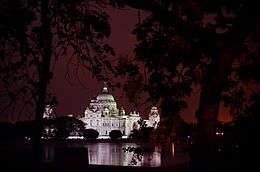
Music
The Baul tradition is a unique heritage of Bengali folk music, which has also been influenced by regional music traditions.[13] Other folk music forms include Kabigaan, Gombhira, Bhawaiya, kirtans, and Gajan festival music. Folk music in West Bengal is often accompanied by the ektara, a one-stringed instrument. West Bengal also has a heritage in North Indian classical music. The state is recognised for its appreciation of rabindrasangeet (songs written by Rabindranath Tagore) and Indian classical music. Nazrul Geeti is another classical music of Bengal, which is written and composed by poet Kazi Nazrul Islam. He was person in Bengal music who created the first Bengali ghazals.
Popular music genres include adhunik songs.[14][15] Since the early 1990s, new genres have emerged, including one comprising alternative folk–rock Bengali bands.[14] Another new style, jibonmukhi gaan ("songs about life"), is based on realism.[16] UNESCO selected The Rural Craft Hub of Bengal to showcase their artwork in Paris in 2015.[17]
Attire
Though Bengali women traditionally wear the sari and shalwar kameez, Western attire has gained acceptance among younger and professional women.[18] Western-style dress has greater acceptance among men, although the traditional costumes like dhoti, panjabi, kurta, sherwani, pyjama and lungi are seen during weddings and major festivals. Like any other metropolis, Kolkata also has an eclectic mix of western wears with a tinge of ethnic wears. People are found dressed in jeans along with kurtas, or sari along with an overcoat.
Festivals and celebrations
West Bengal is famous for its culture and festivals are an inevitable part of this culture. People of different religions and communities perform their religious rituals with festivities. Some festivals are celebrated statewide, while others are local in nature. There are also various other village fairs and seasonal tribal festivals. Durga Puja is the biggest and most important festival of West Bengal, and it features colourful pandals, decorative idols of Hindu goddess Durga and her family, lighting decoration and immersion processions. Other major festivals are Kali Puja, Diwali, Holi, Saraswati Puja, Jagaddhatri Puja, Rath Jatra, Kojagori Lakshmi Puja, Vishwakarma Puja, Poush Parbon, Poila Boishakh, Eid, Muharram, Christmas etc. Kolkata Book Fair, Kolkata International Film Festival and Dover Lane Music Festival are major annual cultural events of Kolkata, whereas Poush Mela, Ganga Sagar Mela, Jhapan are some of the major annual fairs of the state. The diverse ethnic populace of Darjeeling Himalayan hill region celebrates several local festivals such as Losar, Dusshera or Fulpati, Tihar, Ram Navami, Maghe Sankranti, Chotrul Duchen, Buddha Jayanti, Tendong Lho Rumfaat etc.
 Durga Puja, biggest festival of West Bengal
Durga Puja, biggest festival of West Bengal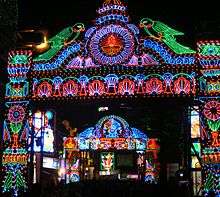 Glittering lighting decorations during Durga Puja.
Glittering lighting decorations during Durga Puja.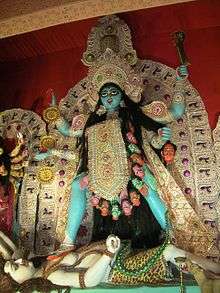 Kali Puja, a major festival of West Bengal
Kali Puja, a major festival of West Bengal- Saraswati Puja
 Rath Jatra is widely celebrated in Bengal
Rath Jatra is widely celebrated in Bengal.jpg) Bandel Church
Bandel Church Colours for Holi on sale at a market
Colours for Holi on sale at a market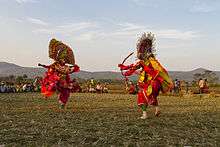 Chhau Mask dance parforming in the field
Chhau Mask dance parforming in the field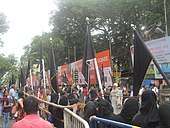 Muslims gather at Muharram procession in Kolkata
Muslims gather at Muharram procession in Kolkata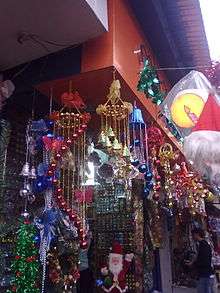 Shops selling Christmas decorations in Kolkata
Shops selling Christmas decorations in Kolkata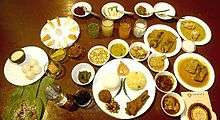 Poila Baisakh festive meal
Poila Baisakh festive meal- Shoppers at the Poush Mela Fair
- Jagaddhatri Puja in Kolkata
 Kapil Muni Temple at Sagardwip
Kapil Muni Temple at Sagardwip
See also
References
- Chaudhuri, Nirad C. (2001). The autobiography of an unknown Indian. New York Review of Books. p. 269. ISBN 978-0-940322-82-0.
- Reeves, Philip (5 April 2007). "Calcutta: habitat of the Indian intellectual". National Public Radio. Retrieved 29 January 2012.
- Noble, Allen and Frank Costa; Ashok Dutt; Robert Kent (1990). Regional development and planning for the 21st century : new priorities, new philosophies. Ashgate Pub Ltd. pp. 282, 396. ISBN 978-1-84014-800-8.
- "Kolkata culture: Para". Department of Tourism, Government of West Bengal. Archived from the original on 21 December 2011. Retrieved 9 December 2011.
- Trachtenberg, P. (15 May 2005). "The chattering masses". The New York Times. Archived from the original on 5 December 2013. Retrieved 26 April 2006.
- Mukherjee Pandey, Jhimli (1 November 2008). "Presidency old-timers to relive days of canteen adda". Times of India. Archived from the original on 7 July 2012. Retrieved 23 January 2012.
- Dutt, R.C. (1962). Cultural heritage of Bengal. Calcutta: Punthi Pustak. cited in Sengupta, Nitish K. (2001). History of the Bengali-speaking people. UBS Publishers' Distributors Pvt. Ltd. pp. 211–12. ISBN 81-7476-355-4.
- "India: The hungry generation". Time. 20 November 1964. Retrieved 24 January 2012.
- Chakraborty, Ajanta (5 July 2011). "Meet the new Mamata Banerjee". Times of India. Archived from the original on 8 July 2012. Retrieved 23 January 2012.
The jatra industry based out of Kolkata's Chitpur Road has gone through a severe blow with the growth of video parlours.
- Niyogi, Subhro (26 October 2010). "Red alert For Jatra". Times of India. Archived from the original on 7 July 2012. Retrieved 23 January 2012.
- Sarkar, Bhaskar (March 2008). "The melodramas of globalization". Cultural Dynamics. 20 (1): 31–51 [34]. doi:10.1177/0921374007088054..
- Gooptu, Sharmistha (2010). Bengali cinema: 'an other nation'. Taylor & Francis. pp. 2, 172, 181, 187. ISBN 978-0-415-57006-0. Retrieved 24 January 2012.
- "The Bauls of Bengal". Folk Music. BengalOnline. Retrieved 26 October 2006.
- Dorin, Stéphane (2005). "La globalisation du rock vue de Calcutta" [The globalization of rock to Calcutta]. Volume! (in French). 4 (1): 144–45. Retrieved 29 January 2012.
- Shepherd, John (2005). Continuum encyclopedia of popular music of the world. 3–7. Continuum. pp. 70–71. ISBN 978-0-8264-7436-0.
- Bhattacharya, Malini (2005). "Culture". In Bagchi, Jasodhara (ed.). The changing status of women in West Bengal, 1970–2000: the challenge ahead. New Delhi: Sage Publications. p. 105. ISBN 978-0-7619-3242-0. Retrieved 10 February 2012.
- Roy, Tasmayee Laha (5 February 2016). "West Bengal rural craft hubs help artisans double their incomes". The Economic Times. Retrieved 13 February 2018.
- Yengkhom, Sumati (23 September 2010). "This Puja, buzz over western clothes". Times of India. Archived from the original on 11 July 2012. Retrieved 23 January 2012.
